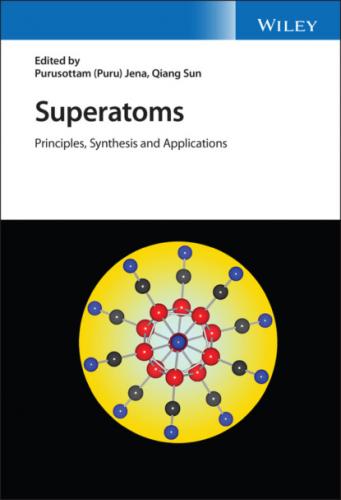Puru Jena
Qiang Sun
List of Contributors
Hong Fang Department of Physics, Virginia Commonwealth University, Richmond, VA, USA
Nicola Gaston The MacDiarmid Institute for Advanced Materials and Nanotechnology, Department of Physics, The University of Auckland, Auckland, New Zealand
Hannu Häkkinen Departments of Physics and Chemistry, Nanoscience Center, University of Jyväskylä, Jyväskylä, Finland
Purusottam (Puru) Jena Department of Physics, Virginia Commonwealth University, Richmond, VA, USA
Vijay Kumar Center for Informatics, School of Natural Sciences, Shiv Nadar University, Tehsil Dadri, Uttar Pradesh, India Dr. Vijay Kumar Foundation, Gurgaon, Haryana, India
Tingwei Li School of Materials Science and Engineering, Peking University, Beijing, China Center for Applied Physics and Technology, Peking University, Beijing, China
Zhifeng Liu School of Physical Science and Technology, Inner Mongolia University, Hohhot, Inner Mongolia, China
Haoming Shen School of Materials Science and Engineering, Peking University, Beijing, China Center for Applied Physics and Technology, Peking University, Beijing, China
Piotr Skurski Laboratory of Quantum Chemistry, Faculty of Chemistry, University of Gdańsk, Gdańsk, Poland Henry Eyring Center for Theoretical Chemistry, Department of Chemistry, University of Utah, Salt Lake City, UT, USA
Qiang Sun School of Materials Science and Engineering, Peking University, Beijing, China Center for Applied Physics and Technology, Peking University, Beijing, China
Shinjiro Takano Department of Chemistry, School of Science, The University of Tokyo, Tokyo, Japan
Tatsuya Tsukuda Department of Chemistry, School of Science, The University of Tokyo, Tokyo, Japan Elements Strategy Initiative for Catalysts and Batteries (ESICB), Kyoto University, Kyoto, Japan
Menghao Wu School of Physics, Huazhong University of Science and Technology, Wuhan, Hubei, China
1 Introduction
Puru Jena1, and Qiang Sun2,3
1 Physics Department, Virginia Commonwealth University, Richmond, Virginia, USA
2 School of Materials Science and Engineering, Peking University, Beijing, China
3 Center for Applied Physics and Technology, Peking University, Beijing, China
Atomic clusters are a group of homo‐ or hetero‐nuclear atoms that form in the gas phase when a hot plume of atoms cool through collisions with noble gas atoms. Once mass is isolated in a quadrupole or time of flight mass spectrometer, these clusters are studied with atomic precision. Although both molecules and atomic clusters are composed of a group of atoms, the similarity ends there. Molecules are found in nature and are stable under ambient conditions, while clusters are produced in the laboratory and are stable only when held in isolation. In addition, unlike molecules, clusters of any size and composition, in principle, can be formed. The early motivation for studying clusters was to understand how properties of matter evolve, one atom at a time. It was soon realized that the structure and properties of clusters are unique and do not resemble their bulk properties until their sizes are very large. Equally important, their properties vary nonmonotonically and unpredictably with size, shape, and composition. This realization gave clusters their own identity, and they came to represent a new phase of matter intermediate between the atoms and their bulk matter. The field of cluster science, born over half a century ago, has attracted scientists from different disciplines to study, understand, and manipulate their properties by changing size, shape, composition, charge, and environment [1–136]. More than 200 000 papers have appeared in this field with about 10 000 papers appearing per year over the past decade. Clusters now bridge disciplines, and their role in the design and synthesis of novel materials with tailored properties is the subject of this book.
In 1992 in an article in Physical Review Letters, Shiv Khanna and Puru Jena showed that a cluster with specific size and composition could mimic the properties of an element in the periodic table and named such a cluster as a “superatom” [137]. They further suggested that these superatoms could be used to build a three‐dimensional periodic table with superatoms forming the third dimension [138]. Furthermore, a new class of materials, called “cluster‐assembled materials” [138], can be formed by using superatomic clusters as building blocks, much as conventional materials are formed by using atoms as building blocks. This concept originated from a seminal experiment in the field of cluster science by Walter Knight and his group in 1984 [139]. These authors measured the mass spectra of Na clusters and observed that clusters containing 2, 8, 20, 40, . . . atoms are more abundant than their neighbors (see Figure 1.1). They noted that the nuclei with the same number of nucleons were already known to be very stable. In analogy with the nuclear physics, the authors termed these very stable clusters as magic clusters and showed that the origin of the magic numbers in Na clusters is due to electronic shell closure, just as the magic numbers in nuclei are due to nuclear shell closure.
Knight et al. described the electronic shell structure of Na clusters using the jellium model where the clusters were assumed to have spherical symmetry with the charges of the positive ion core distributed uniformly inside the sphere (see Figure 1.2) [140]. They assumed that valence electrons in Na clusters would behave like free electrons, similar to the conduction electrons in a Na metal. In the jellium model of a cluster, the charge density n +(r) of the positive ions is given by,
